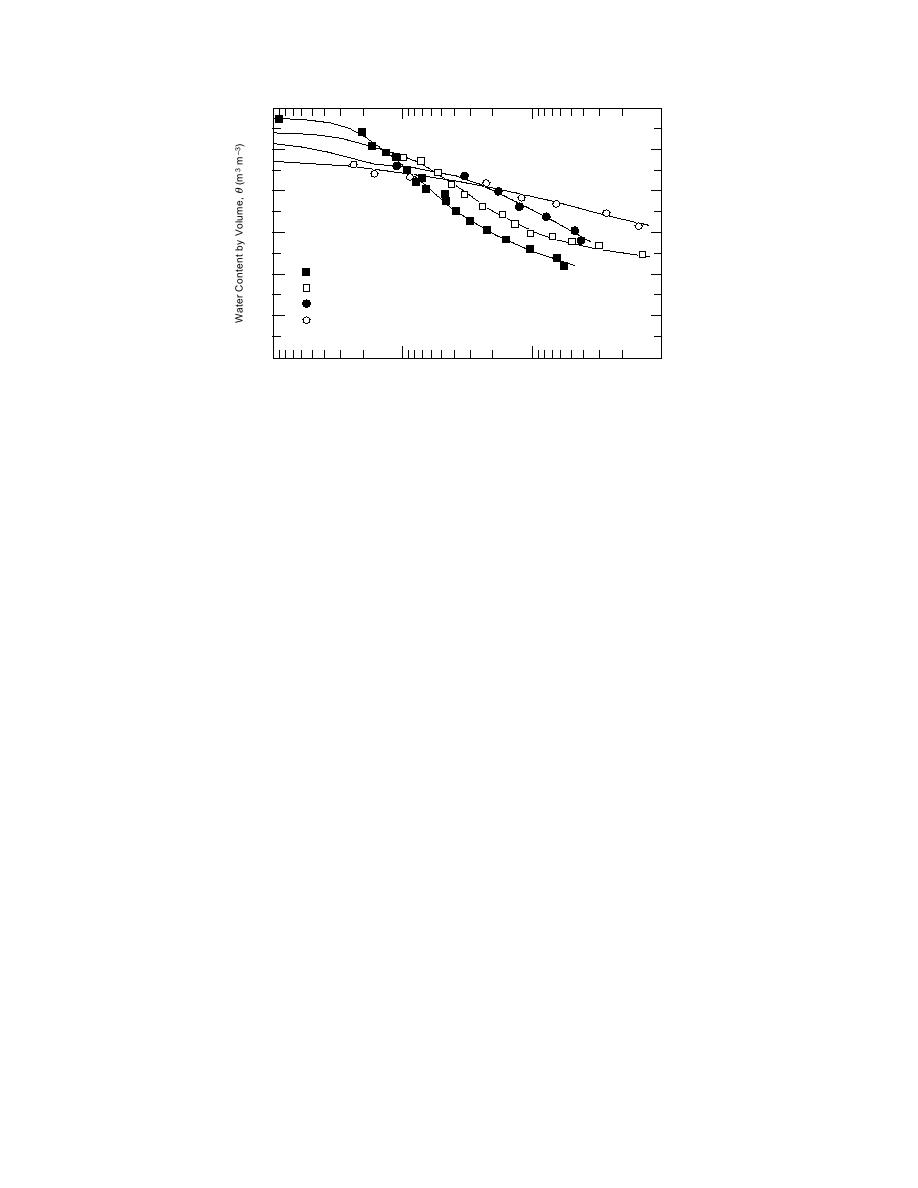
0.6
0.5
0.4
0.3
ρb = 1.09 mg m3
0.2
ρb = 1.28 mg m3
ρb = 1.48 mg m3
ρb = 1.66 mg m3
0.1
0.0
0.1
1
10
100
Matric Potential (kPa)
Figure 2. Water retention characteristics of Nicollet clay loam at vari-
ous bulk densities; dense soils hold less water at high matric potential
and more water at low potential. (After Gupta et al. 1989.)
Increases surface runoff and accelerates soil
Establishes or breaks bonds in aggregates
erosion (Foltz 1992, van Ouwerkerk and
and among particles (Koolen and Kuipers
Soane 1994).
1983).
Compacted soil particles can be loosened by the
Crushes soil aggregates, thus making the soil
shrinking and swelling associated with wetting
particle distribution more uniform, which
and drying of clays (Larson and Allmaras 1971),
tends to reduce soil pore size distribution,
by root growth and by soil freezethaw (FT), so
which changes the soil water suction and
that the infiltration rate of a previously compacted
water retention characteristics (Taylor and
soil often returns to or near to its previous values
Box 1961, Koolen and Kuipers 1983, Gupta et
(Canarache 1991, Thurow et al. 1993). The ice that
al. 1989, Cruse and Gupta 1991) (Fig. 2).
forms in soil pores during freezing can reduce the
Increases the volumetric water content be-
density of compacted soil by pushing soil grains
cause the applied stresses act for a very short
apart and reducing their degree of interlocking.
time during compaction, which strongly
This is most effective when volumetric soil water
restricts the amount of water that moves out
content approaches soil porosity. The amount of
of the soil, i.e., traps the water (Hillel 1980,
soil ice formed in pores or as lenses is related to the
Koolen and Kuipers 1983).
volume of soil water present when freezing starts
Reduces the volume of soil voids, which
and the volume drawn to the freezing zone from
reduces total porosity and increases dry bulk
the subsoil (Miller 1980).
density (Hillel 1980, Kooistra and Tovey
Upon thawing, a soil is usually less dense,
1994).
although the degree of FT-induced soil expansion
Changes soil pore geometry (Gupta et al.
depends on soil water content, soil texture and
1989) and reduces the interconnectedness of
depth, the rate of frost penetration, the number of
larger pores (Hillel 1980, Iverson 1980).
FT cycles, and the depth of compaction (Webb et
Increases soil penetration resistance (Voor-
al. 1983). This soil loosening can be sufficient to
hees et al. 1986), especially with rubber tires,
increase infiltration and reduce runoff, especially
not tracks (Braunack 1986b).
in arid and semi-arid environments (Schumm and
Decreases soil infiltration (Akram and Kem-
Lusby 1963). However, research results to date
per 1979) (Fig. 3) and permeability (Braunack
conflict regarding the degree of FT-induced loos-
1986a,b); and if, during trafficking, the vehi-
ening, as discussed below.
cles' wheels slip, realigns soil particles paral-
Chamberlain and Gow (1979) found that FT
lel to the direction of the shear forces, which
reduced void ratio and increased vertical perme-
causes additional compaction and further re-
ability, while Blake et al. (1976) found that FT did
duces infiltration (Gupta et al. 1989).
3



 Previous Page
Previous Page
